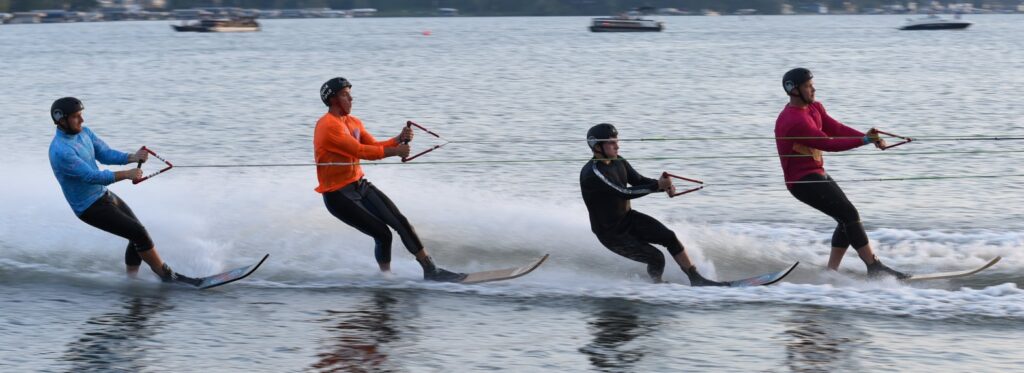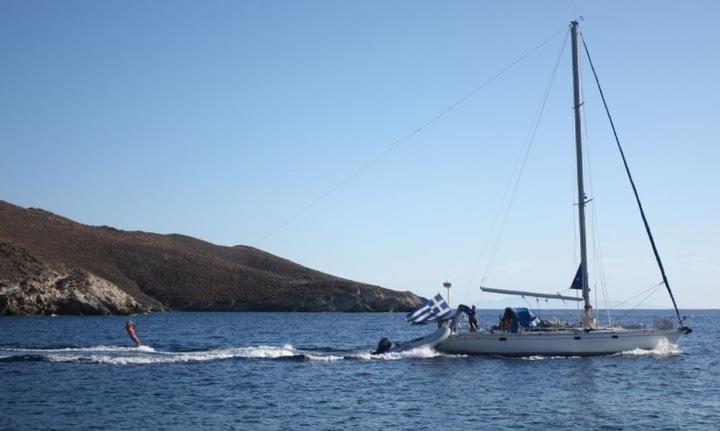Can You Water Ski Behind a Sailboat?
If you’re a sailor but also a watersports enthusiast, you may be wondering what type of boat is suitable for water skiing. Firstly, it’s all about power to weight ratios. Meaning that you know what to expect if you add a 200-pound guy behind a 3000-pound boat… This is about a 7% increase in weight, and note also the additional drag, for the drive system of that boat. But, 200 pounds behind a 14,000-pound boat is considerably less, about 1%, so you probably wouldn’t even understand there’s someone back there, provided the boat isn’t underpowered. But, we will analyze this and many other factors further in this article and eventually see if it’s possible to waterski behind a sailboat. Follow me!
Waterskiing
When being a sailor, you’re keen on everything that is about the sea and the marine world. So, it’s not just sailing. You explore the ocean, its species, and you can also engage in many different activities, such as watersports. Waterskiing has been a popular and beloved watersport for many. It proved to sailors that their boats could be more than transportation or a fishing vessel. From two skis to one ski, to no skis at all, it’s a sport that can be challenging, fun, and also painful. But for those new to watersports, it’s a great place, to begin with.
Waterskiing is done with two different skis, one for each foot. Start in the water, lined up behind the boat with the rope in your hands. Maintain a slight bend in your knees and a near distance between your feet. When you give your driver the go-ahead, they’ll accelerate to full speed, which is your cue to hold on and let the boat do the majority of the work.
Slalom Skiing: Slalom skiing is identical to normal skiing except that one of the skis is removed. The easiest way to get started is with two skis and then drop one along the way. Just don’t forget to return to retrieve the other ski. It’s possible to do a full start on just one ski once you’ve gained confidence.
Barefoot Skiing: You can also ditch the skis entirely to enjoy a real challenge. Barefoot skiing is the most challenging type of skiing, and it usually necessitates some kind of preparation before trying it. Starting barefoot skiing in the water, standing up from a kneeboard or wakeboard, or dismounting from a slalom ski are all options in order to get started.
Hydrofoiling: Hydrofoiling is an odd sport, and is similar to seated skiing. The hydrofoil consists of three parts including the seat tower, board, and foil assembly. This acts as a rudder in order to help with direction. When riders start they strap into the seat and then lean back. They have to hold the rope but keeping the front tip of the board out of the water. When the boat starts, the foil assembly will lift the board off the surface of the water and elevate the rider up into the air.
Types of Boats you can Water Ski Behind
Many types of boats, including dedicated ski and wakeboard boats, some fishing and jon boats, outboard boats, bowriders, and even big cruiser boats, can easily tow a skier on doubles. However, slalom skiers, particularly beginners and heavier skiers, will require more power to get out of the water. The size and weight of the boat are also significant considerations. A 14-foot boat with an 18-horsepower engine could be capable of towing a child on double skis. An 18-foot bass boat, on the other hand, would need at least 75 horsepower to tow an experienced skier on double skis.
In general, almost any boat that can plane can be used to ski behind. Skiing on two skis involves a relatively low speed, such as 25 mph, and that’s all you need from a boat anyway. To adequately pull a slalom (single ski) skier, however, you’ll need more power. The quicker you can pull a good trick skier out of the water, particularly a bigger skier, the more horsepower you have. Even so, many classic Chris Crafts ski inboard boats had just 60-80 horsepower and were perfectly adequate for slalom skiing.
In any case, you should be equipped with a pylon or a tower for the rope in the boat that will be used for skiing. Like this, you will be able to circle around to pick up the skier without the rope being twisted or in the way. Although a larger boat (20’+) can definitely be used to ski behind, it will usually produce a larger wake that is better suited for wakeboarding than skiing.

Is it Possible to Water Ski behind a Cruiser?
The term cruiser refers to larger boats in the 22 to 44 ft range – e.g. a Beneteau First 25S. Keep in mind that a bigger cruiser boat with a 350 HP engine will typically have enough acceleration to pull a skier out of the water. Meaning that cruisers often don’t have very good holeshots. In other words, the ability to get up on plane and up to speed quickly from a halt. So, the skier will often be plowing water for longer than with a smaller boat. This might result in fatigue for just getting out of the hole.
Another disadvantage for water skiing behind bigger boats is a very wide turning radius. This means you need a larger area for skiing as you can’t do tight turns. In addition, cruisers make it more difficult and more time-consuming to recover a fallen skier. Especially when there are other boats around. With cruiser boats, it’s harder to find and maintain the best possible speed for pulling a skier, as that speed generally sits between getting out of the water and reaching planing speed. And, at that point, the speed jumps up and becomes too high for the skier.
Another common problem while skiing on a cruiser is visibility. On a small lake or river, it’s difficult to see what’s going on around the boat and determine how much room the skier has to cut the wake. Larger vessels have a higher bow, which reduces visibility. The high fuel consumption of cruisers for skiing is another disadvantage. On the positive side, with a 38′ cruiser, you could be able to pull up to 5 skiers at once. But, this will increase the costs in terms of fuel.
Can you Water Ski Behind an Outboard Boat?
Water skiing is best done with outboards in the 22 to 24-foot range with a single engine and not with a twin-engine. For experienced skiers, outboard boats have excellent wakes, and they’re better than inboard boats for beginners. This way, you’re able to get away with a less-than-perfect shape.
In comparison to inboards or I/O, however, getting up on a single ski requires more effort. When skiing behind an outboard, the turns are often not as smooth. A 23-foot fish boat with an outboard engine and a deep V hull can typically tow three double skiers. The drawback is that the wake it creates may be too large for slalom skiing.
When compared to an inboard with a deeper hull, skiing behind an outboard has the advantage of being able to run on sandbars with ease. If you want an outboard, you’ll almost certainly need a tow pylon in front of the boat. Alternatively, you can use a bridle with a block in the back. In quick turns, this will help to reduce the pull of heavier riders on the stern. Overall, if you’re looking for a family boat that can also be used for recreational skiing or a distance slalom ski, outboards are a good compromise.
Useful Tips for Tow Sports
Going skiing, wakeboarding, or surfing can be quite simple if you purchase a specialized tow-sports boat. However, a center-mounted tow pylon is unlikely to be found behind the standard family runabout or center console. You’re also unlikely to have a built-in ballast system for creating large wakes for wake sports. With the below-mentioned boating and driving tips, you will enhance the overall water-skiing, wakeboarding, or tubing experience.
- Do not attempt to surf behind your boat unless you have an inboard engine, jet drive, or forward-facing sterndrive. To be safe for boats with outboard or sterndrive power, surfing necessitates getting too close to the transom.
- Depending on the watersport, you will need a different selection of towropes. Water-ski ropes are typically 75 feet in length and beginner wakeboard ropes typically run between 65 to 75 feet. On the other hand, tube ropes should fall between 50 to 60 feet. Most wakeboarders prefer no-stretch ropes, while many water-skiers prefer ropes with some stretch. Make sure a tube rope’s weight capacity suits the weight capacity of the tube it’s towing.
- Rope positioning is also different, again depending on the watersport. On slalom courses, skiers prefer the rope attached to a pylon close to the middle of the boat, which aids carving. However, wakeboarders like to perform airborne tricks with a high tow point (from a tower). Keep in mind that the tube’s tow line has to be near the transom and off a low pylon or tow eye. This is because flipping or sending a tube aloft is significantly increased when it is tethered to a tower.
- When the skier is up, work the throttle with your thumb and index finger. Furthermore, use your elbow on an armrest so as to make a light touch and find the right spot for the skier. Also, you will probably make some slight adjustments with both the throttle and the wheel. This is because skiers make a pull on the transom as they cut far out of the wake.
- In case a skier falls, then throttle back to idle before turning. Like this, you won’t swamp the skier with a wake. Approach the skier at idle speed from the downwind side so as not to accidentally drift or be blown on top of him. And, in case the skier is reboarding the boat, always stop the engine before he gets close.
- Another important thing you have to consider is how to handle the throttle. Running and gunning don’t really work. You have to bring the throttle forward when pulling the skier in order not to yank the rope out of his hands. When on plane, wakeboarders prefer boat speeds between 18 to 22 mph. However, slalom water-skiers prefer speeds between 25 to 36 mph. Moreover, beginner skiers on two skis need slow speeds when the boat is just on plane, typically around 16 to 20 mph.
Can You Water Ski Behind a Sailboat? – The Bottom Line
Although it’s not ideal, yes, it is possible to waterski behind a sailboat too! But, keep in mind that you have to empty the boat as much as possible, including ballast. In addition, depending on the boat’s size and type, you might have to drop the mast and the boom and leave ashore or at least the boom and sail. Also, rig a bridle between rear stanchion bases or rear cleats. Allow it to slack enough to drop down behind the motor but not far enough to touch the water. Then, head outside the rudders. Finally, attach your floating ski or tube line to the center of the bridle and let the fun begin!
